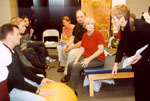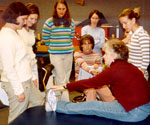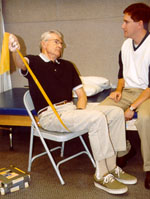Community service good for students, patients
by Dick PetersonPublic Relations
Students learn and patients benefit. And the arrangement helps make physical therapy associate professor Lisa Saladin happy at the end of her day.
 Lisa
Saladin demonstrates to her students an arm movement to help MS patient
Elizabeth Peterson (center) increase her range of motion.
Lisa
Saladin demonstrates to her students an arm movement to help MS patient
Elizabeth Peterson (center) increase her range of motion.
“I love it. I come home on a high,” Saladin said, describing the feeling she gets from working with her students to provide patients with pro bono physical therapy services. Many of the patients wouldn’t get therapy otherwise.
The ability to adapt a physical therapy regimen to an individual’s need is but half of her high. The other is the rich learning environment the patients give her students in return.
“A lot of us here (in the College of Health Professions) have been providing community service and want to do more,” she said. “Coming from Canada where physical therapy is accessible to all as part of the national health coverage, I am committed to increasing access to physical therapy services here.”
 At
the direction of physical therapy students, patient Faith Stanley stretches
to touch her toe. She has been plagued with leg cramps related to her MS.
At
the direction of physical therapy students, patient Faith Stanley stretches
to touch her toe. She has been plagued with leg cramps related to her MS.
She and her students began working for free with patients with neurological disorders “as long as they were willing to work with my students as well.” The patients she and her students see are usually those whose insurance coverage has run out but who still need more therapy. “We primarily work with patients who have multiple sclerosis, stroke, Parkinson’s disease and traumatic brain injuries,” she said.
“I like working with the students,” said multiple sclerosis patient Faith Stanley at a session last week with Saladin’s physical therapy students. “They know the exercises I need to do to make my life easier.” Stanley suffers from severe leg cramps related to her MS. She also told how their watching her walk with her cane and a simple adjustment in the length of her cane now helps her maintain her balance and walk more upright and normally.
The students met with three patients—about six students with each—listened to their concerns, evaluated the extent of their disabilities and recommended practical ways to increase flexibility, range of motion and other means of compensating for the paralysis they are experiencing.
 Douglas
Bobo of Hilton Head stretches a elastic strap to strengthen muscles in
his right arm. The students use a series of color-coded straps of various
tensions to enhance muscle tone threatened with atrophy from MS paralysis.
Douglas
Bobo of Hilton Head stretches a elastic strap to strengthen muscles in
his right arm. The students use a series of color-coded straps of various
tensions to enhance muscle tone threatened with atrophy from MS paralysis.
Multiple sclerosis is a progressively debilitating disease that attacks the central nervous system by breaking down the layer of myelin cells insulating the nerves. Depending on their location, lesions forming on the myelin sheath interrupt electrical signals from the brain, causing muscle paralysis, vision loss, difficulty swallowing and other problems.
Students working with MS patient Elizabeth Peterson positioned her in ways that would allow her to move and flex weakened muscles with the least resistance. And they showed her muscle-strengthening exercises that could be performed while sitting at her desk. Much of what the physical therapy students recommend is tailored to the specific needs and abilities of the individual patient.
Peterson, who organizes a daytime multiple sclerosis support group in Summerville, said that Saladin and her students have prepared special exercises to enhance flexibility and mobility for people with disabilities. The exercises they developed for her group adapt the physical benefits of yoga and water aerobics to aid people with multiple sclerosis who are severely limited by fatigue in addition to their paralysis.
“They've actually come to our support group meetings, they have joined us in the pool to demonstrate how these exercises are done and to explain how the exercises can help us,” Peterson said.
“Sessions like these bring together the textbook aspects of physical therapy training with the human aspects,” said third-year student George Washburn. “And it certainly helps us understand what the person is going through.”
Tina Paysinger, also in her third and final year of physical therapy training, recognizes the hope patients gain from the attention she and others give them. “Even little changes in the way they do things make a difference to them,” she said.
She said that PT students are required to either give a class presentation or present a physical therapy topic to a community group. “I recently presented to a post-polio support group on ways to reduce joint pain.”
Catalyst Online is published weekly, updated as
needed and improved from time to time by the MUSC Office of Public Relations
for the faculty, employees and students of the Medical University of South
Carolina. Catalyst Online editor, Kim Draughn, can be reached at 792-4107
or by email, catalyst@musc.edu. Editorial copy can be submitted to Catalyst
Online and to The Catalyst in print by fax, 792-6723, or by email to petersnd@musc.edu
or catalyst@musc.edu. To place an ad in The Catalyst hardcopy, call Community
Press at 849-1778.